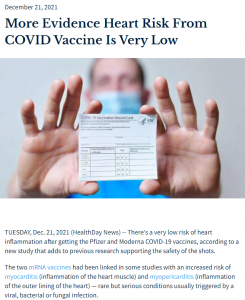Gene therapy is a class of drugs with numerous side effects which means that have long-term consequences for the public.
Drugs never cure disease; they only change its form and location. . . . When drugs are introduced into the system, for a time they seem to have a beneficial effect. A change may take place, but the disease is not cured. It will manifest itself in some other form. . . . The disease which the drug was given to cure may disappear, but only to reappear in a new form, such as skin diseases, ulcers, painful, diseased joints, and sometimes in a more dangerous and deadly form. . . . Nature keeps struggling, and the patient suffers with different ailments, until there is a sudden breaking down in her efforts, and death follows.–H. to L., Chap. 3, p. 60. {HL 243.3} Published 1864
When we have these pro- ‘vaccination’ publications that do not consider-
The many adverse effects
The long term consequences
Natural immunity
The abnormally high level of reactions compared to other vaccines pre-covid
The small chance of serious side effects from the covid variant omicron
ARTERIOSCLEROSIS, THROMBOSIS, VASCULAR BIOLOGY
SESSION TITLE: DAMPS, INFECTION AND CARDIOVASCULAR METABOLISM
Abstract 10712: Observational Findings of PULS Cardiac Test Findings for Inflammatory Markers in Patients Receiving mRNA Vaccines
Abstract
This clinic has been using the PULS Cardiac Test (Predictive Health Diagnostics Co., Irvine, CA) a clinically utilized measurement of multiple protein biomarkers, which generates a score predicting the 5 yr risk (percentage chance) of a new Acute Coronary Syndrome (ACS) called the PULS Score. The score is based on changes from the norm of multiple protein inflammatory biomarkers including IL-16, a proinflammatory cytokine, soluble Fas, an inducer of apoptosis, and Hepatocyte Growth Factor (HGF) which serves as a marker for chemotaxis of T-cells into epithelium and cardiac tissue, among other markers. Elevation above the norm increases the PULS score, while decreases below the norm lowers the PULS score. The PULS score has been measured every 3-6 months in our patient population for 8 years. Recently, with the advent of the mRNA COVID 19 vaccines (vac) by Moderna and Pfizer, we tracked the changes of the PULS score and three of the inflammatory markers it measures in all of our patients consecutively receiving these vaccines.
This report summarizes those results. A total of 566 pts, aged 28 to 97, M:F ratio 1:1 seen in a preventive cardiology practice had a previously scheduled PULS test drawn from 2 to 10 weeks following the 2nd mRNA COVID shot and was compared to the pt’s PULS test drawn 3 to 5 months previously pre-shot. Each vac pt’s PULS score and inflammatory marker changes were compared to their pre-vac PULS score, thus serving as their own control. There was no comparison made with unvaccinated patients or pts treated with other vaccines.
Baseline IL-16 increased from 35+/-20 above the norm to 82 +/- 75 above the norm post-vac; sFas increased from 22+/- 15 above the norm to 46+/-24 above the norm post vac; HGF increased from 42+/-12 above the norm to 86+/-31 above the norm post vac. These changes resulted in an increase of the pre vac PULS score of predicted 11% 5 yr ACS risk to a post vac PULS score of a predicted 25% 5 yr ACS risk, based on data which has not been validated in this population. No statistical comparison was done in this observational study.
In conclusion, the mRNA vacs numerically increase (but not statistically tested) the markers IL-16, Fas, and HGF, all markers previously described by others for denoting inflammation on the endothelium and T cell infiltration of cardiac muscle, in a consecutive series of a single clinic patient population receiving mRNA vaccines without a control group.
